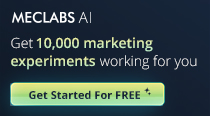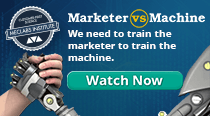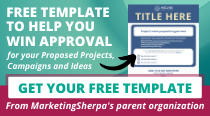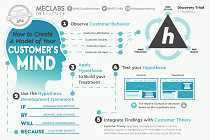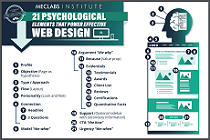February 21, 2003
Case Study
SUMMARY:
When the only thing your site sells is luggage tags, your traffic
is necessarily limited so you have to get the highest conversions
you possibly can.
Learn the five specific tactics Crew Tags used to improve it's
conversion rates from 10% to 25% recently. Yes, they apply to
anyone selling online no matter how big or small you are, and no
matter what you sell.
|
|
CHALLENGE
Airline pilot Michael Worth sat down one day and
created a custom luggage tag for his crew bag. His colleagues
liked it, so he made a few for them. And then everyone wanted
one, so he started selling them.
Next thing he knew he had a success story on his hands; "We sold
just a ton of them to that one little airline."
Then in Q4, 1995, around the same time Pierre Omidyar was
founding eBay, Worth thought, "let's throw this thing on the Web
and see how that does."
When orders started coming in from flight crews in Australia and
Japan, he knew he was on to a winner, so he quit the day job and,
"did the dot-com thing full-time."
More than 7 years later, Crew Tags is still in business, now
selling colorful luggage tags to consumers and flight crews
around the world. How is it possible to make a living selling
something so very, very niche (one highly specific item at a
low price-point) to consumers online?
We asked Worth for his tips on surviving the e-commerce rat race
in a tight niche with tiny margins.
CAMPAIGN
Custom personalized luggage tags are a niche within a
niche. With tags retailing at just $5.95 each, Worth's found
he does not have the margins or market to get worthwhile returns
from advertising.
How does he get visitors?
He admits that word of mouth is far and away his best source, as
with any quality product with excellent customer service. As far
as flight crews are concerned, "These guys are locked in a metal
tube together for several hours and they've got nothing better to
talk about than luggage tags, so that works really well."
Worth uses three additional tactics to drive site traffic:
Traffic tactic #1: Print your URL on your product
Rather than just promote the website on paperwork and packaging,
Worth prints the URL on each tag that goes out the door; "The URL
appears in small, light gray print under the picture on side two
of the tag, in copyright fashion."
Traffic tactic #2: Do not forget old-fashioned links
Worth says, "We went out there and spent a lot of hours surfing
the web going to every little [related] site, no matter how
insignificant it seemed, and saying 'hey, link to us'. We got
hundreds and hundreds of links. We did it to drive people to us
and then there's now the issue of link popularity."
Link building is a tricky business these days.
Larger companies neglect them because they assume big brands
attract their own links or think (wrongly) link building is for
small-timers only. Popular websites are increasingly wary of
"giving away" links for free, knowing their value for positioning
in search engines such as Google.
Worth says he still benefits from links from many non-
commercial sites that in effect represent his target market,
getting the equivalent of a link "endorsement" from places such
as flight attendant or pilot unions, for example.
Traffic tactic #3: If you can not get in front of your target
audience online, partner with someone who can
A fan of the very popular 'This is True' weird news site, Worth
talked with publisher Randy Cassingham about turning the site's
infamous "Get out of Hell Free" cards into laminated luggage
tags, wallet cards and keychains.
Now Cassingham drives qualified traffic to the relevant Crew Tags
sales pages, in return for a royalty percentage from GOOHF sales.
Worth applied the same concept to Chris Pirillo's LockerGnome,
another popular niche content site, and produces tags and
keychains featuring the "Lockergnome girls" and a Pirillo-shaped
emoticon.
He does the same offline, producing custom designs for local
non-profits, for example.
Nevertheless, being so specialized, Worth knows he is only
ever going to get a limited number of visitors (even though he is
top 3 for the right keywords in all the main search engines).
His success depends on having an above-average visitor-to-
buyer conversion rate.
Over 7 years he has watched his customer communications and site
logfiles to get insights into how he can improve the way he
presents and sells his products. After years of tweaking, he did
a major overhaul of the website in October 2002 to put all those
insights into practice.
Conversion tactic #1: Put product benefits up front and kill the
jargon and buzzwords
Worth writes the site copy himself and now begins the homepage
with the following benefit-laden greeting:
Is your luggage boring?
Yeah, we thought so.
Crew Tags manufactures brightly colored, personalized
luggage tags to help you spot your bag on the carousel
more easily. We have more than 500 options to make your
luggage stand out, and help prevent thievery, or loss.
Thousands sold to airline crews and weary travelers
world wide."
His aim is to identify the benefits of a custom tag up front, and
use a warm, humorous style that, "makes people realize there are
humans here, we're not just a machine. And people enjoy a little
flash of humor."
This writing style is carried through the whole site,
particularly in the site's FAQ, where you will find questions like,
"How do I know that they will survive the tortures of my
airline's bag smashers union?"
Conversion tactic #2: Answer visitor questions before they think
to ask them
Worth tracked the questions visitors were emailing in, and found
many were asking the same questions about images, product sizes
and other typical customer concerns. Not only was he spending a
lot of time answering all that mail, but he was losing impulse
sales while visitors waited for a reply.
He reorganized the site's pages to ensure that potential
problems or questions could be answered at the site, and then
placed links to these pages at the top left of the menu column so
they are the first thing visitors see.
Worth says the link layout and uncluttered site design is, "the
result of years of paying attention to the problems we had,
listening to people's questions, and incorporating all that into
a website design that answers all these problems and questions."
FAQ, Warranty Information, Shipping Rates, and Testimonials are
the lead links, so that customers can find immediate answers to
any concerns about the purchase, products or ordering process.
Conversion tactic #3: Make the warranty more meaningful
Although Worth offers a one year warranty, he is aware of the
"warranty: Yeah, big deal" factor, where people expect a
lightweight product to break the day after the warranty period
expires.
Instead of just saying there is a warranty and money-back
guarantee, the warranty page links to the "torture test;" a story, with picture, of failed attempts to destroy a tag using razor
blades and fire (and eventual success with a firearm).
He explains, "I wanted to send the message that this is an
incredibly durable product despite its thin, lightweight
appearance. I set out to destroy a tag, put it through more pain
than it would ever experience during the course of a trip on your
luggage."
Conversion tactic #4: Handhold shoppers through a flexible
ordering process
Worth noted the company was getting a lot of similar phone calls
from customers. "The phone rang constantly; people were trying to
order over the web and getting confused, or they wanted to do
something specific and the website wouldn't let them do it."
He redesigned the ordering process to include two key
features. First, he added a "create a tag" link and placed it in
the group of prominent links at the top of the site menu.
Customers following this link choose which images they want on
both sides of their tag from the full catalog range.
Second, he reworked the ordering scripts to simplify the process.
Customers order their tags one stage at a time, beginning with
the backside image, then the personalized text, then the
frontside image.
At each stage, the site displays the "results so far," meaning
you see a picture of a tag with your current design and
personalized text built in. After finishing each building stage,
you must then confirm (or amend) the details before moving on to
the next stage.
Conversion tactic #5: Diversify, even if you have a small niche
In the first few years, Worth just sold custom airline-design
tags to pilots and crews. "Then I opened my eyes one day and
said, 'I've got all my eggs in one basket, I can't be serving
nothing but airline crews'."
He expanded his range of tag designs to tap the broader
traveling public, featuring everything from emoticons to animals
to military motifs. He tries to introduce new products every
month, focusing on fun, non-airline stuff to expand the market.
(The decision was a business-saver. Post Sept.11, the airlines
shed 250,000 jobs and a huge chunk of Worth's flight crew sales
went with them.)
RESULTS
Following the Oct 2002 website changes, CrewTags.com
has improved conversion rates (visitors to buyers) from an
average 10% to over 25%. Yes, that means one in every four
visitors is placing an order.
Worth attributes the high initial conversion rate to pre-
qualified traffic, since 89% of his 500-600 daily visitors come
through bookmarks or direct type-ins. He says the post-
October increase is mainly a consequence of the website changes.
For example, 75-80% of orders begin through the new "create-a-
tag" link rather than through a category choice. Worth says
adding that option, "is the most important thing we ever did.
Right away from day 1 people started mixing and matching in ways
I never even thought of."
He says the real secret of 7 years in the e-commerce business
is a simple one, "The most important thing we do is build quality
product and do everything possible to ensure every customer is
happy no matter what. That's marketing."
http://www.crewtags.com


